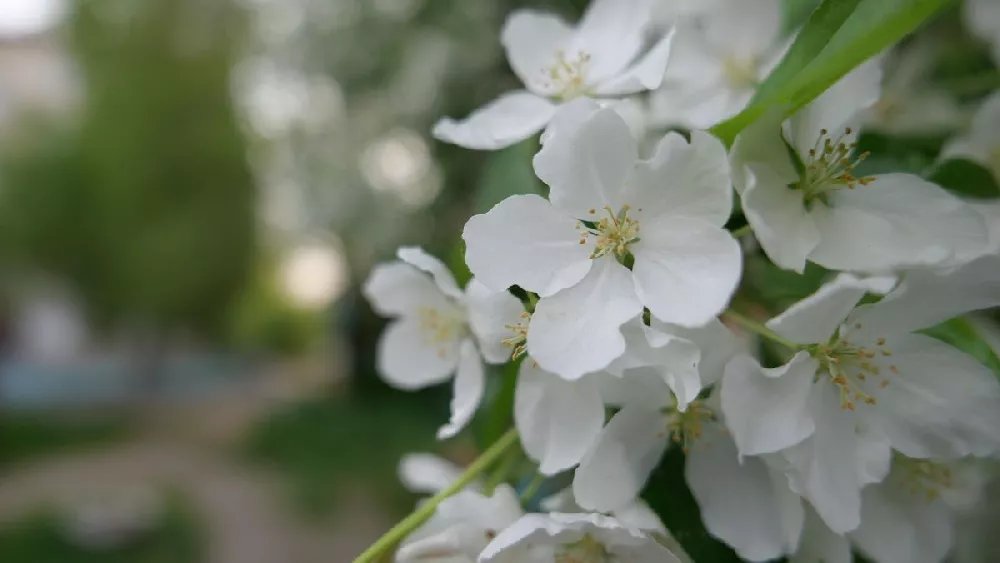- Home >
- Flowers >
- Trees and Plants with White Flowers >
- Sweet Sugar Tyme® Crabapple
Sweet Sugar Tyme® Crabapple for Sale - Buying & Growing Guide
- Ships in 1-2 days
- 1-Year Warranty Eligible
- Pots or accessories are not included unless specified in the product options.
Shipping Details:
Once your order is shipped, you’ll receive an email with a tracking number and estimated delivery date. Most orders ship immediately, but some items are seasonal and may only ship in spring or fall. These products are noted on the website.
Although there are hundreds of crabapple cultivars on the market, the Sweet Sugar Tyme® Crabapple, Malus 'Swesutyzam,’ stands head and shoulders above most of them. There are several reasons for this. The first being the flowers. They start as small pink buds, but then open up into pretty white flowers with large yellow stamens that cover the tree completely, turning it into a horticultural snowball. After the flowers fade, the tree's attractive dark green leaves and ample canopy provide summer interest and shade. In the fall, the leaves turn bronze and yellow, offering another show-stopping view. But, late winter may just be this tree's best season, as it is covered in vivid, shiny red berries that are a boon for winter songbirds and small mammals and which persist on the trees until spring. Not convinced? Here are a few more reasons to plant this lovely tree:
- Can be grown throughout most of the continental U.S.
- Needs little extra care or pruning.
- Disease and pest-resistant.
Plant Care
Sunlight

The Sweet Sugar Tyme® Crabapple thrives in full sunlight, six or more hours of direct sunlight each day.
Watering
Water young trees weekly; once established, they will only need water in very hot or dry weather.
Fertilizing

Fertilize with a balanced, slow-release product in spring, such as a 5-5-5 formula.
Planting and Care
Planting instructions
Site your tree in soil that drains well and receives at least six hours of direct sunlight a day. Unpot your sapling, and tease out any encircling roots, which can girdle the tree and slowly kill it. Dig a hole that’s as deep as the root ball and twice as wide. Place the tree in the hole, spreading out the roots. Holding the tree upright and steady, fill in around the roots with topsoil that’s been mixed with well-rotted compost or manure, tamping down as you go to eliminate air pockets. Water thoroughly. Apply a two to three-inch layer of organic mulch such as bark chips around the root zone to conserve water and hinder weed growth but keep it from touching the trunk to avoid problems with rot.
Watering and nutrients
For the first year after planting, water your tree weekly throughout the growing season, giving it about an inch of water each time. If you have very hot or dry weather, increase watering to several times a week. Once established, these trees are fairly drought-resistant and shouldn’t need supplemental water unless you’re experiencing very dry weather. Fertilize in early spring before the tree flowers with a balanced, slow-release product designed for landscape trees and shrubs, such as a 5-5-5 formula.
Pollination
The Sweet Sugar Tyme® Crabapple is monoecious, or self-fertile, and you will be able to harvest crabapples with only one tree. You will, however, reap more fruit if you plant another crabapple nearby. Bees and wasps are the primary agents of pollination, moving the pollen from male to female reproductive organs on each tree.
Pruning
Prune out any dead, diseased or damaged branches whenever you see them. You shouldn’t need to prune for shape, but if you wish to lightly prune to open up the canopy for better air circulation, do it after the tree has flowered.
Pests and diseases
Few pests or diseases bother this cultivar, so it’s rare to have any issues with your Sweet Sugar Tyme® Crabapple. Pests that are sometimes seen on crabapples include aphids, mites and Japanese beetles. Traps for the latter are available at most garden stores. Light infestations shouldn’t bother your tree but if insect pressure is heavy, consider releasing beneficial insects such as ladybugs and lacewings to attack them. Diseases of the crabapple include fire blight and cedar apple rust, but these are unlikely to be seen on the Sweet Sugar Tyme® Crabapple since it is resistant to them.
Harvesting
If you are interested in harvesting the fruit from your crabapple, wait to do so until the fruits have turned a vivid red. A ripe crabapple will have dark brown seeds when you cut it open; unripe fruit has light seeds. You can also try biting into one. It should be crisp and firm, but not difficult to bite.
Achieving maximum results
If you live in an area where it’s too cold to grow the Sweet Sugar Tyme® Crabapple outdoors or if you’d like to set up one or more on a patio or deck, you’ll be pleased to know that you can grow crabapples in containers. Choose a pot that is about twice the size of the root ball with good drainage in the bottom. Use a good-quality potting mix and follow our directions for planting. Note that potted plants may need more watering and fertilizer than those planted in the ground. Plan on repotting your tree with fresh soil every four or five years. If you live in a cold region, bring it indoors in the winter to a cool spot such as a basement or garage.
FAQs
How big does the Sweet Sugar Tyme® Crabapple get?
This is a petite cultivar, and only achieves a mature height of around 10 feet, with a width of 10 feet as well. This makes it an excellent choice for smaller gardens and spots where a larger tree or shrub would be out of place.
Where can I grow the Sweet Sugar Tyme® Crabapple?
The Sweet Sugar Tyme® Crabapple is hardy down to -20 degrees Fahrenheit, which corresponds to USDA hardiness zones four through eight. That encompasses much of the continental U.S. You can successfully grow these crabapples as far north as coastal Maine and in all but the most subtropical regions in the far south.
How is the Sweet Sugar Tyme® Crabapple best used in my garden?
The Sweet Sugar Tyme® Crabapple would make an excellent specimen planting for a smaller garden or yard. Consider planting a grouping of three or five in a front yard, underplanted with a shade-loving ground cover or ivy. They would make a lovely addition to a cottage garden and would work as an accent planting in a larger garden or landscape setting.
Compare Similar Products
You can't add more Product Name - Product size to the cart.
OK






